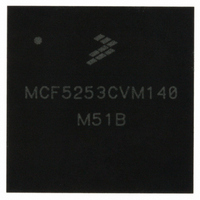MCF5253CVM140 Freescale Semiconductor, MCF5253CVM140 Datasheet - Page 545

MCF5253CVM140
Manufacturer Part Number
MCF5253CVM140
Description
IC MPU 32BIT 140MHZ 225-MAPBGA
Manufacturer
Freescale Semiconductor
Series
MCF525xr
Datasheets
1.MCF5253VM140J.pdf
(34 pages)
2.MCF5253VM140J.pdf
(8 pages)
3.MCF5253VM140J.pdf
(648 pages)
4.MCF5253VM140J.pdf
(2 pages)
Specifications of MCF5253CVM140
Core Processor
Coldfire V2
Core Size
32-Bit
Speed
140MHz
Connectivity
CAN, EBI/EMI, I²C, QSPI, UART/USART, USB OTG
Peripherals
DMA, WDT
Program Memory Type
ROMless
Ram Size
128K x 8
Voltage - Supply (vcc/vdd)
1.08 V ~ 1.32 V
Data Converters
A/D 6x12b
Oscillator Type
External
Operating Temperature
-40°C ~ 85°C
Package / Case
225-MAPBGA
Family Name
MCF5xxx
Device Core
ColdFire V2
Device Core Size
32b
Frequency (max)
140MHz
Instruction Set Architecture
RISC
Supply Voltage 1 (typ)
1.2/3.3V
Operating Supply Voltage (max)
1.32/3.6V
Operating Supply Voltage (min)
1.08/3V
Operating Temp Range
-40C to 85C
Operating Temperature Classification
Industrial
Mounting
Surface Mount
Pin Count
225
Package Type
MA-BGA
Lead Free Status / RoHS Status
Lead free / RoHS Compliant
Number Of I /o
-
Eeprom Size
-
Program Memory Size
-
Lead Free Status / Rohs Status
Compliant
Available stocks
Company
Part Number
Manufacturer
Quantity
Price
Company:
Part Number:
MCF5253CVM140
Manufacturer:
FREESCALE
Quantity:
300
Company:
Part Number:
MCF5253CVM140
Manufacturer:
Freescale Semiconductor
Quantity:
10 000
Part Number:
MCF5253CVM140
Manufacturer:
FREESCALE
Quantity:
20 000
Company:
Part Number:
MCF5253CVM140J
Manufacturer:
Freescale Semiconductor
Quantity:
10 000
- MCF5253VM140J PDF datasheet
- MCF5253VM140J PDF datasheet #2
- MCF5253VM140J PDF datasheet #3
- MCF5253VM140J PDF datasheet #4
- Current page: 545 of 648
- Download datasheet (8Mb)
Alternatively, a host controller implementation is allowed to traverse the entire asynchronous schedule list
(for example, observed the head of the queue (twice)) before setting the Advance on Async status bit.
The software may re-use the memory associated with the removed queue heads after it observes the
Interrupt on Async Advance status bit is set, following assertion of the doorbell. The software should
acknowledge the Interrupt on Async Advance status as indicated in the USBSTS register, before using the
doorbell handshake again
24.9.9.3
EHCI uses two bits to detect when the asynchronous schedule is empty. The queue head data structure (see
Figure
the head of the reclaim list. host controller also keeps a 1-bit flag in the USBSTS register (Reclamation)
that is cleared when the host controller observes a queue head with the H-bit set. The reclamation flag in
the status register is set when any USB transaction from the asynchronous schedule is executed (or
whenever the asynchronous schedule starts, see
Start Event.”
If the controller ever encounters an H-bit of one and a Reclamation bit of zero, the controller simply stops
traversal of the asynchronous schedule.
An example illustrating the H-bit in a schedule is shown in
Freescale Semiconductor
24-41) defines an H-bit in the queue head, which allows the software to mark a queue head as being
HC State
Empty Asynchronous Schedule Detection
A
A
Memory State
Before Unlink
B
Async-Advance Doorbell = 0
Figure 24-49. Generic Queue Head Unlink Scenario
USBCMD Interrupt on
C
HC State
MCF5253 Reference Manual, Rev. 1
D
A
USBSTS Interrupt on Async-Advance = 1
D
Async-Advance Doorbell = 0
After Doorbell
Memory State
B
USBCMD Interrupt on
Section 24.9.9.4, “Asynchronous Schedule Traversal:
C
HC State
Figure
After Unlink (B, C) and at Doorbell
A
A
USBSTS Interrupt on Async-Advance = 0
D
24-50.
Async-Advance Doorbell = 1
Memory State
B
USBCMD Interrupt on
C
Universal Serial Bus Interface
D
24-83
Related parts for MCF5253CVM140
Image
Part Number
Description
Manufacturer
Datasheet
Request
R
Part Number:
Description:
Mcf5253 Coldfire? Microprocessor Data Sheet
Manufacturer:
Freescale Semiconductor, Inc
Datasheet:
Part Number:
Description:
Manufacturer:
Freescale Semiconductor, Inc
Datasheet:
Part Number:
Description:
Manufacturer:
Freescale Semiconductor, Inc
Datasheet:
Part Number:
Description:
Manufacturer:
Freescale Semiconductor, Inc
Datasheet:
Part Number:
Description:
Manufacturer:
Freescale Semiconductor, Inc
Datasheet:
Part Number:
Description:
Manufacturer:
Freescale Semiconductor, Inc
Datasheet:
Part Number:
Description:
Manufacturer:
Freescale Semiconductor, Inc
Datasheet:
Part Number:
Description:
Manufacturer:
Freescale Semiconductor, Inc
Datasheet:
Part Number:
Description:
Manufacturer:
Freescale Semiconductor, Inc
Datasheet:
Part Number:
Description:
Manufacturer:
Freescale Semiconductor, Inc
Datasheet:
Part Number:
Description:
Manufacturer:
Freescale Semiconductor, Inc
Datasheet:
Part Number:
Description:
Manufacturer:
Freescale Semiconductor, Inc
Datasheet:
Part Number:
Description:
Manufacturer:
Freescale Semiconductor, Inc
Datasheet:
Part Number:
Description:
Manufacturer:
Freescale Semiconductor, Inc
Datasheet:
Part Number:
Description:
Manufacturer:
Freescale Semiconductor, Inc
Datasheet:











